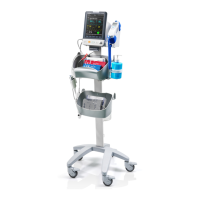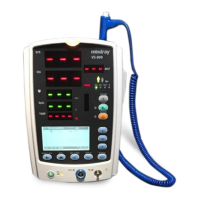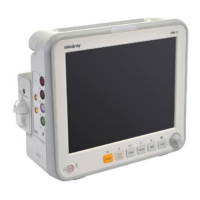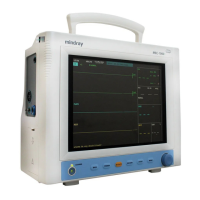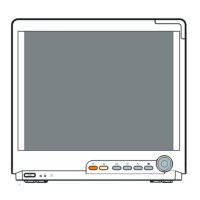VS 8/VS 8A Vital Signs Monitor Operator’s Manual 6 - 1
6 Monitoring Pulse Oxygen Saturation
(SpO
2
)
6.1 SpO
2
Introduction
Pulse Oxygen Saturation (SpO
2
) monitoring is a non-invasive technique used to measure
the amount of oxygenated hemoglobin and pulse rate by measuring the absorption of
selected wavelengths of light. The light generated in the emitter side of the probe is
partly absorbed when it passes through the monitored tissue. The amount of
transmitted light is detected in the detector side of the probe. When the pulsative part
of the light signal is examined, the amount of light absorbed by the hemoglobin is
measured and the pulse oxygen saturation can be calculated. This device is calibrated to
display functional oxygen saturation.
SpO
2
monitoring is intended for adult, pediatric and neonatal patients.
The monitor can be configured with the following SpO
2
modules:
■ Masimo SpO
2
: the connector is purple and the logo of Masimo SET is on the
monitor.
■ Nellcor SpO
2
: the connector is grey and the logo of Nellcor is on the monitor.
• The SpO
2
extension cable used must be compatible with the SpO
2
sensor
connectors used. For example, only the Mindray SpO
2
extension cable can be
connected to the Mindray SpO
2
sensor connectors.
• Measurement accuracy verification: The SpO
2
accuracy has been verified in
human experiments by comparing with arterial blood sample reference
measured with a CO-oximeter. Pulse oximeter measurement are statistically
distributed and about two-thirds of the measurements are expected to come
within the specified accuracy range compared to CO-oximeter
measurements.
• A functional tester or SpO
2
simulator can be used to determine the pulse rate
accuracy.
• A functional tester or SpO
2
simulator cannot be used to assess the SpO
2
accuracy.
• When a trend toward patient deoxygenation is indicated, analyze the blood
samples with a laboratory co-oximeter to completely understand the
patient’s condition.
• Do not use SpO
2
sensors during magnetic resonance imaging (MRI). Induced
current could potentially cause burns. The sensor may affect the MRI image,
and the MRI unit may affect the accuracy of the oximetry measurements.
• Prolonged continuous monitoring may increase the risk of undesirable
changes in skin characteristics, such as irritation, reddening, blistering or
burns. Inspect the sensor site every two hours and move the sensor if the skin
quality changes. Change the application site every four hours. For neonates,
or patients with poor peripheral blood circulation or sensitive skin, inspect
the sensor site more frequently.
• If the sensor is too tight because the application site is too large or becomes
too large due to edema, excessive pressure for prolonged periods may result
in venous congestion distal from the application site, leading to interstitial
edema and tissue ischemia.
• When patients are undergoing photodynamic therapy they may be sensitive
to light sources. Pulse oximetry may be used only under careful clinical
supervision for short time periods to minimize interference with
photodynamic therapy.
• Setting alarm limits to extreme values may cause the alarm system to
become ineffective. For example, high oxygen levels may predispose a
premature infant to retrolental fibroplasia. If this is a consideration, do not
set the high alarm limit to 100%, which is equivalent to switching off the
alarm.
• SpO
2
is empirically calibrated in healthy adult volunteers with normal levels
of carboxyhemoglobin (COHb) and methemoglobin (MetHb).
• To protect from electric shock, always remove the sensor before bathing the
patient.
• The pulse oximetry function of the bedside monitor should not be used for
apnea monitoring.
• The pulse oximetry function of the bedside monitor should not be used for
arrhythmia analysis.
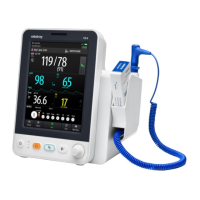
